Dissertation on The Freight Forwarder Industry
55 Pages15157 Words28 Views
Added on 2020-04-07
Dissertation on The Freight Forwarder Industry
Added on 2020-04-07
ShareRelated Documents
RUNNING HEAD: Dissertation
Dissertation
Name of the Student:
Name of the University:
Author note:
Dissertation
Name of the Student:
Name of the University:
Author note:
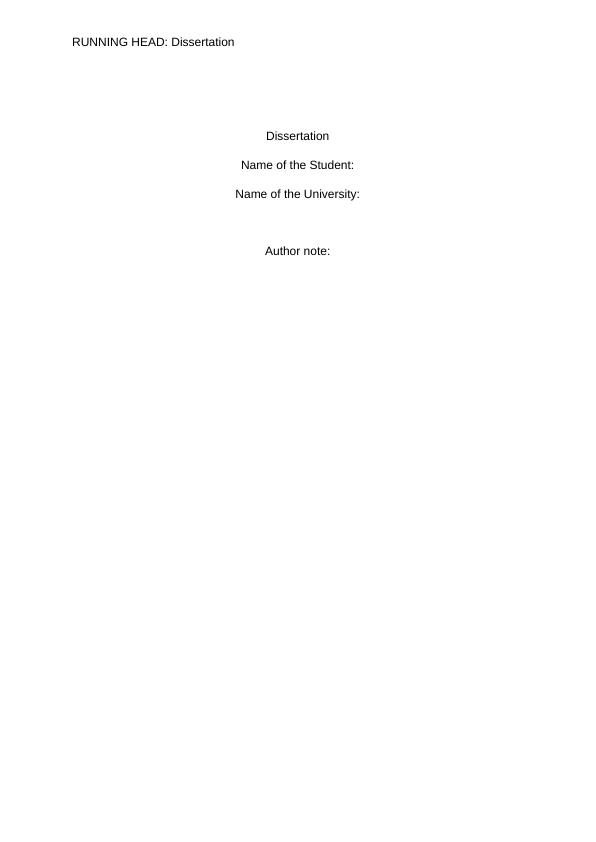
1
Abstract:
The freight forwarder industry is one of the most significant industries in Singapore,
actively contributing to the growth of its economy. However, companies have been
experiencing employee turnover issues, whereby factors such as low wages or lack
of career progression have compelled the workers to look for other companies. The
high rate of employee turnover is indeed a problem, as it affects the revenue growth
of the company, while also leading to stalling productivity growth amongst the
workers. Hence, it has become imperative to conduct a research and investigate the
factors leading to such high employee turnover rates in the industry. The absence of
employee growth and training opportunities or absence of employee recognition
might be the common reasons behind this. Hence, the present research intends to
conduct a survey and critically analyse the factors and provide recommendations
which contribute to the problem of high employee turnover rate in the industry. It is a
well-known fact that high rate of employee turnover entails increased expenditure on
fresh training and induction, as well as a reduced rate in employee productivity.
Further, this can also affect employee motivation and brand reputation of the
company at large. Hence, the research will help in exploring the real reasons behind
the high employee turnover in the freight forwarder industry of Singapore and solving
the problem of employee turnover to a considerable extent.
Table of Contents
Abstract:
The freight forwarder industry is one of the most significant industries in Singapore,
actively contributing to the growth of its economy. However, companies have been
experiencing employee turnover issues, whereby factors such as low wages or lack
of career progression have compelled the workers to look for other companies. The
high rate of employee turnover is indeed a problem, as it affects the revenue growth
of the company, while also leading to stalling productivity growth amongst the
workers. Hence, it has become imperative to conduct a research and investigate the
factors leading to such high employee turnover rates in the industry. The absence of
employee growth and training opportunities or absence of employee recognition
might be the common reasons behind this. Hence, the present research intends to
conduct a survey and critically analyse the factors and provide recommendations
which contribute to the problem of high employee turnover rate in the industry. It is a
well-known fact that high rate of employee turnover entails increased expenditure on
fresh training and induction, as well as a reduced rate in employee productivity.
Further, this can also affect employee motivation and brand reputation of the
company at large. Hence, the research will help in exploring the real reasons behind
the high employee turnover in the freight forwarder industry of Singapore and solving
the problem of employee turnover to a considerable extent.
Table of Contents
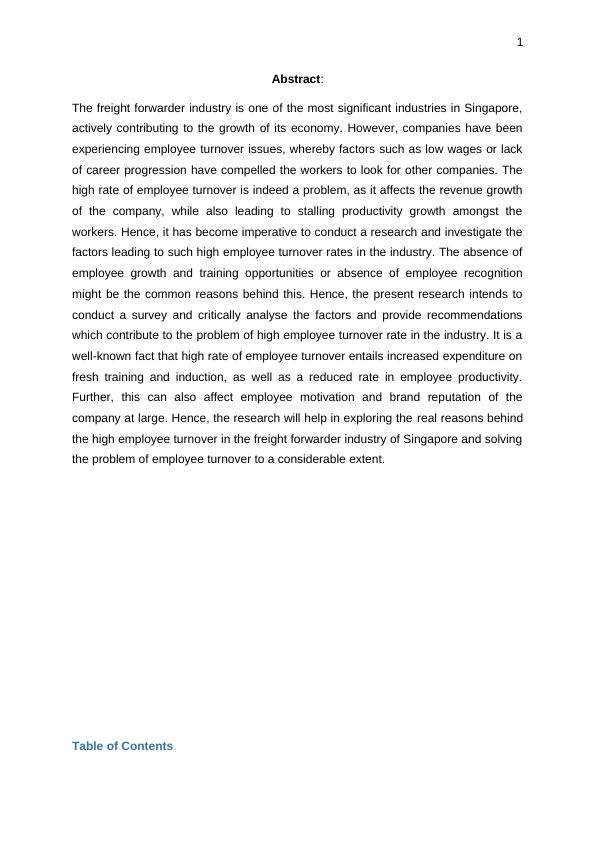
2
Chapter 1: Introduction.................................................................................................4
1.1 Background.........................................................................................................4
1.2 Aim of the study...................................................................................................6
1.3 Objectives of the study........................................................................................7
Chapter 2: Literature Review........................................................................................8
2.1 Employee Retention............................................................................................8
2.2 Freight Forwarder Industry..................................................................................9
2.3 Management practices......................................................................................10
2.3.1 Personality for the job.................................................................................11
2.4 Lack of training and opportunities.....................................................................11
2.5 Lack of supervisory figure.................................................................................12
2.5.1 Appraisal.....................................................................................................13
2.6 Quality of Work environment.............................................................................13
2.6.1 Atmosphere.................................................................................................13
2.7 Lack of career progression and remuneration..................................................14
Chapter 3: Research Methodology.............................................................................16
3.1 Research Question...............................................................................................16
3.2 Research Choice..................................................................................................16
3.2.1 Research Approach.......................................................................................16
3.2.2 Research Design............................................................................................17
3.3 Types of data........................................................................................................18
3.4 Data Collection Method........................................................................................19
3.5 Sampling and Data Access..................................................................................19
3.6 Ethical and Data Protection Issues......................................................................19
3.7 Data Analysis Method...........................................................................................20
3.8 Limitations.............................................................................................................20
Ch 4: Findings & Discussion.......................................................................................21
4.1 Response rate...................................................................................................21
4.2 Profile of respondents.......................................................................................21
4.3.1 Findings (Section B).......................................................................................23
4.3.2 Findings (Section C).......................................................................................35
4.4 Analysis.............................................................................................................36
Chapter 5 – Conclusion..............................................................................................38
Chapter 1: Introduction.................................................................................................4
1.1 Background.........................................................................................................4
1.2 Aim of the study...................................................................................................6
1.3 Objectives of the study........................................................................................7
Chapter 2: Literature Review........................................................................................8
2.1 Employee Retention............................................................................................8
2.2 Freight Forwarder Industry..................................................................................9
2.3 Management practices......................................................................................10
2.3.1 Personality for the job.................................................................................11
2.4 Lack of training and opportunities.....................................................................11
2.5 Lack of supervisory figure.................................................................................12
2.5.1 Appraisal.....................................................................................................13
2.6 Quality of Work environment.............................................................................13
2.6.1 Atmosphere.................................................................................................13
2.7 Lack of career progression and remuneration..................................................14
Chapter 3: Research Methodology.............................................................................16
3.1 Research Question...............................................................................................16
3.2 Research Choice..................................................................................................16
3.2.1 Research Approach.......................................................................................16
3.2.2 Research Design............................................................................................17
3.3 Types of data........................................................................................................18
3.4 Data Collection Method........................................................................................19
3.5 Sampling and Data Access..................................................................................19
3.6 Ethical and Data Protection Issues......................................................................19
3.7 Data Analysis Method...........................................................................................20
3.8 Limitations.............................................................................................................20
Ch 4: Findings & Discussion.......................................................................................21
4.1 Response rate...................................................................................................21
4.2 Profile of respondents.......................................................................................21
4.3.1 Findings (Section B).......................................................................................23
4.3.2 Findings (Section C).......................................................................................35
4.4 Analysis.............................................................................................................36
Chapter 5 – Conclusion..............................................................................................38
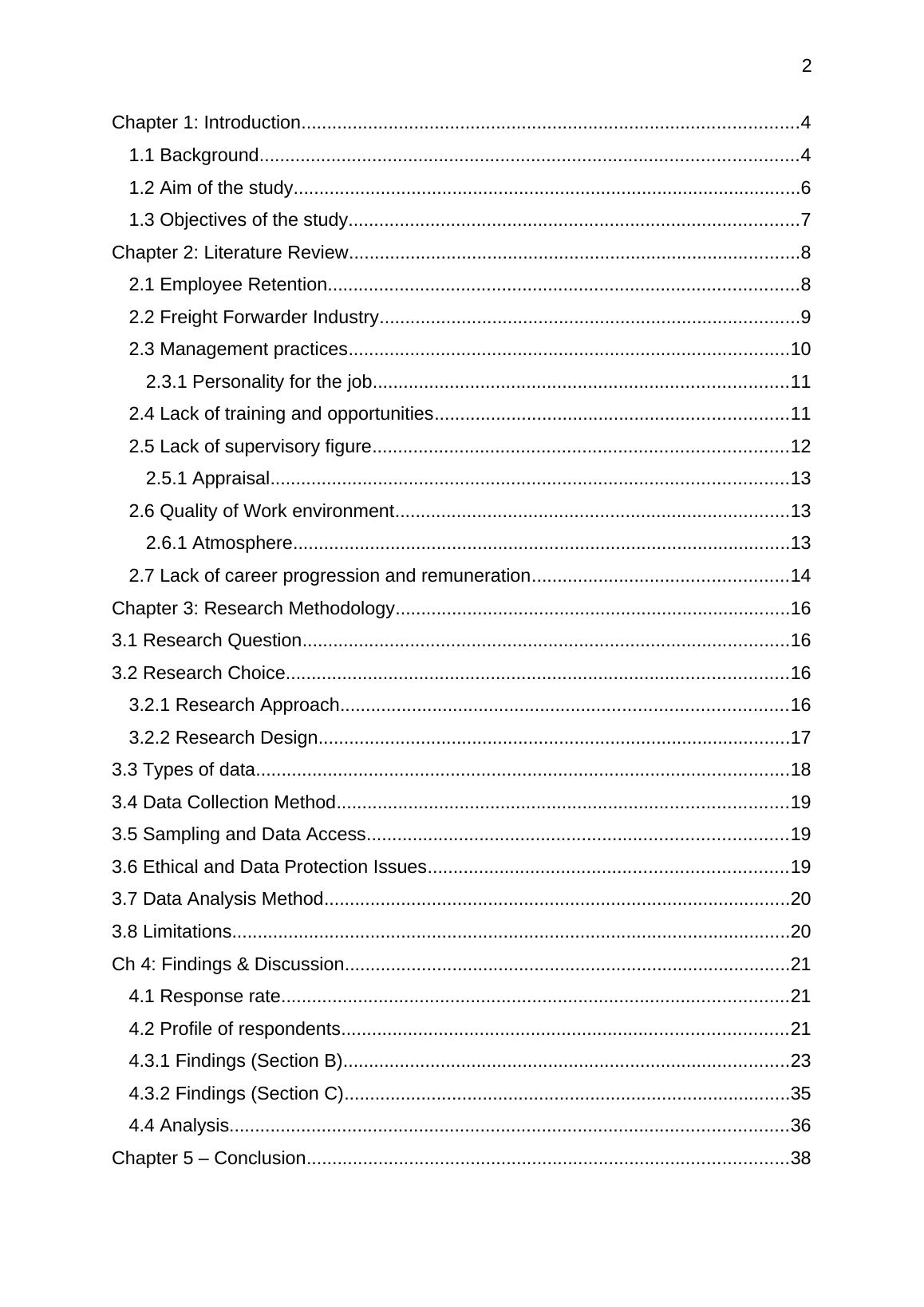
3
5.1 Review of objectives..........................................................................................38
5.2 Theoretical review.............................................................................................38
5.3 Recommendations............................................................................................39
5.4 Limitations.........................................................................................................39
5.5 Suggestions for future research........................................................................40
References.................................................................................................................41
5.1 Review of objectives..........................................................................................38
5.2 Theoretical review.............................................................................................38
5.3 Recommendations............................................................................................39
5.4 Limitations.........................................................................................................39
5.5 Suggestions for future research........................................................................40
References.................................................................................................................41
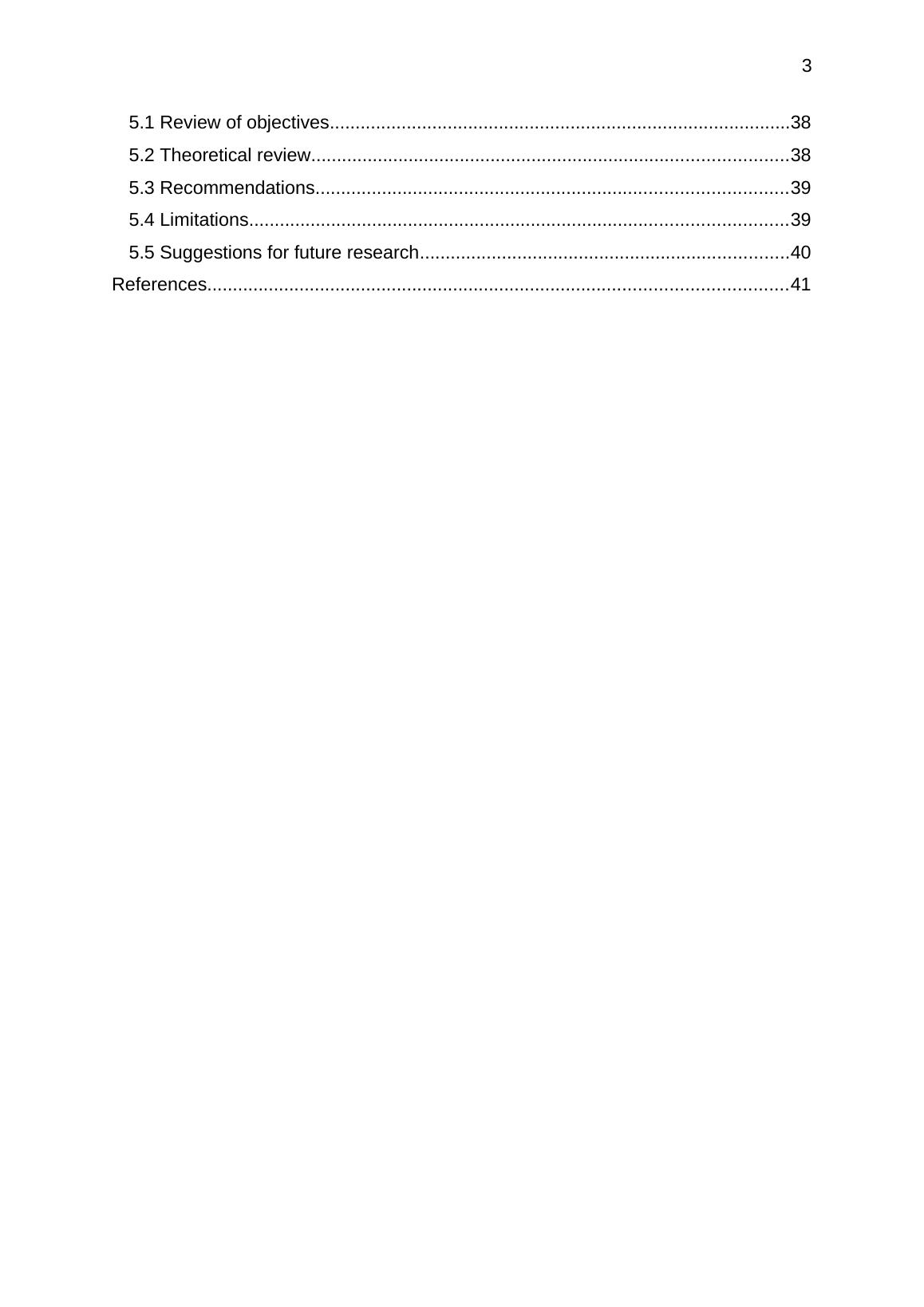
4
LIST OF FIGURES
Figure 4. 1: Frequency distribution of Gender............................................................25
Figure 4. 2: Frequency distribution of Age Group......................................................26
Figure 4. 3: Frequency distribution of Nationality.......................................................27
Figure 4. 4Figure 4: Length of Service.......................................................................27
Figure 4. 5: Response to assignment of mentor as guide.........................................28
Figure 4. 6: Response to whether the employees would like to spend the career with
the company...............................................................................................................29
Figure 4. 7: Response to whether Enjoy discussing the company with outside people
....................................................................................................................................30
Figure 4. 8: Response to how much the employee has learned from the present
company.....................................................................................................................31
Figure 4. 9: Response to how well the employees bonded with colleagues..............31
Figure 4. 10: Response to present salary..................................................................32
Figure 4. 11: Response to encouraging friends to work in the present company......33
Figure 4. 12: Response to I feel motivated to go to work every day..........................33
Figure 4. 13: Response to It is normal to have high turnover in freight forwarding
industry.......................................................................................................................34
Figure 4. 14: Response to High employee turnover is costly and impacts the
organization negatively...............................................................................................35
Figure 4. 15: Cause of High turnover.........................................................................36
Figure 4. 16: There is a high rate of Turnover in your company................................36
Figure 4. 17: Reason for high Turnover.....................................................................37
Figure 4. 18: Your experience in the present company is up to your expectation.....38
Figure 4. 19: If did not meet your expection, why?....................................................38
Figure 4. 20: What factors are most important in a job..............................................39
LIST OF FIGURES
Figure 4. 1: Frequency distribution of Gender............................................................25
Figure 4. 2: Frequency distribution of Age Group......................................................26
Figure 4. 3: Frequency distribution of Nationality.......................................................27
Figure 4. 4Figure 4: Length of Service.......................................................................27
Figure 4. 5: Response to assignment of mentor as guide.........................................28
Figure 4. 6: Response to whether the employees would like to spend the career with
the company...............................................................................................................29
Figure 4. 7: Response to whether Enjoy discussing the company with outside people
....................................................................................................................................30
Figure 4. 8: Response to how much the employee has learned from the present
company.....................................................................................................................31
Figure 4. 9: Response to how well the employees bonded with colleagues..............31
Figure 4. 10: Response to present salary..................................................................32
Figure 4. 11: Response to encouraging friends to work in the present company......33
Figure 4. 12: Response to I feel motivated to go to work every day..........................33
Figure 4. 13: Response to It is normal to have high turnover in freight forwarding
industry.......................................................................................................................34
Figure 4. 14: Response to High employee turnover is costly and impacts the
organization negatively...............................................................................................35
Figure 4. 15: Cause of High turnover.........................................................................36
Figure 4. 16: There is a high rate of Turnover in your company................................36
Figure 4. 17: Reason for high Turnover.....................................................................37
Figure 4. 18: Your experience in the present company is up to your expectation.....38
Figure 4. 19: If did not meet your expection, why?....................................................38
Figure 4. 20: What factors are most important in a job..............................................39
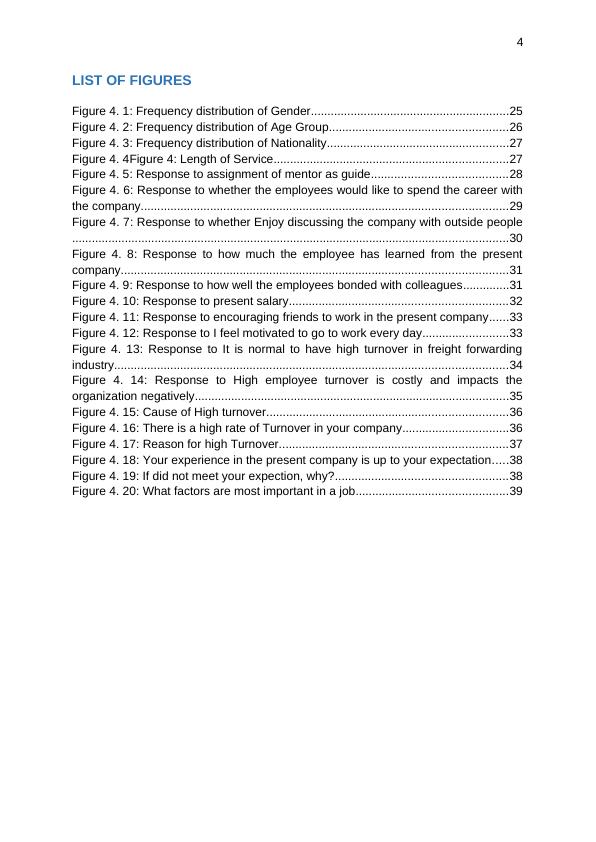
5
Chapter 1: Introduction
1.1 Background
The focus of the study is on the freight forwarders in Singapore and how this industry
is facing the problem of high employee turnover. The factors which create a problem
in retaining the employees will be discussed in detail by going through the primary as
well as secondary sources. The aims and objectives of the study will be achieved by
the end of the study.
Freight forwarders are also known as the agents which organizes the shipments for
the individuals or the companies for transferring it to the markets or final distribution
point. The forwarders have contracts with the multiple carriers which move goods
from place to another. It acts as an expert in the network of logistics. They carry
goods through different modes of shipping like railways, roadways, airways or any
other. Freight forwarding is done for providing efficient and cost effective transfer of
goods in a good condition for the individuals or the companies. They handle the
negotiations, regulations of customs and use latest advances in the technology to
make the processes better (Marder, 2016).
Asia is rising as the new economic powerhouse in the world and the organizations
from across the world are expanding their businesses in Singapore. Singapore is in
the heart of Southeast Asia and it is with the connection to the major shipping lanes
which makes it an important logistics hub for the world trade. It is the prime location
for major logistics firms. The freight forwarders in Singapore are secure and trusted
and are developing because Singapore is developing a trusted supply chain.
Singapore is friendly with the import/ export requirements and procedures. The
companies have efficiencies in obtaining the permit for the goods. The country
provides a platform to the freight forwarders which simplifies the documentation,
saves time and improves the efficiency of the freight forwarders. The freight
forwarders receive the trade permits easily and it is a growing industry. Despite
having such facilities and qualities, there is a huge problem of employee retention
which the industry is facing in Singapore. There may be many reasons behind it.
Chapter 1: Introduction
1.1 Background
The focus of the study is on the freight forwarders in Singapore and how this industry
is facing the problem of high employee turnover. The factors which create a problem
in retaining the employees will be discussed in detail by going through the primary as
well as secondary sources. The aims and objectives of the study will be achieved by
the end of the study.
Freight forwarders are also known as the agents which organizes the shipments for
the individuals or the companies for transferring it to the markets or final distribution
point. The forwarders have contracts with the multiple carriers which move goods
from place to another. It acts as an expert in the network of logistics. They carry
goods through different modes of shipping like railways, roadways, airways or any
other. Freight forwarding is done for providing efficient and cost effective transfer of
goods in a good condition for the individuals or the companies. They handle the
negotiations, regulations of customs and use latest advances in the technology to
make the processes better (Marder, 2016).
Asia is rising as the new economic powerhouse in the world and the organizations
from across the world are expanding their businesses in Singapore. Singapore is in
the heart of Southeast Asia and it is with the connection to the major shipping lanes
which makes it an important logistics hub for the world trade. It is the prime location
for major logistics firms. The freight forwarders in Singapore are secure and trusted
and are developing because Singapore is developing a trusted supply chain.
Singapore is friendly with the import/ export requirements and procedures. The
companies have efficiencies in obtaining the permit for the goods. The country
provides a platform to the freight forwarders which simplifies the documentation,
saves time and improves the efficiency of the freight forwarders. The freight
forwarders receive the trade permits easily and it is a growing industry. Despite
having such facilities and qualities, there is a huge problem of employee retention
which the industry is facing in Singapore. There may be many reasons behind it.

6
These factors will be discussed in the study to know the real reasons behind the high
employee turnover in the freight forwarder industry of Singapore (Banker, 2015).
Employee turnover can be referred to the percentage of workers who leave one
organization and then they are replaced by the other employees. It is the very
important to measure to control the budgets of the organization or industry and to
identify the reasons of low talent in the industry. It can also be referred to the rate at
which the employers lose its employees. As per the report of Logistics (2014),
Singapore is a mature market and here, the businesses need to manage their cost of
employment. People are facing the work Visa challenges which is also creating
frustration for the employees. The labor requirements in Singapore are strict which
have an impact on the cost of labor because the cost of wages for the domestic and
local employees increases. The employees get choosy about the requirements and
needs like distances of travel, payments, job roles, facilities and more. To gain better
salaries and wages, the employees often leave the employers and join another one
which has now become a trend in the country (Aguenza & Som, 2012).
There are several studies conducted on the employee satisfaction and retention in
the industry and it is found that 95% of the human resource leaders admit that when
the employees are exhausted physically or mentally, they tend to leave their jobs
which are increasing the employee turnover rate. The prolonged stress and
frustration in the job contribute a lot to the burnout of employees. As per Garton
(2017), employee burnout is a reason why the companies are bearing so much of
costs. Not only costs but low productivity, loss of talent and high turnover of
employees are some of the evils which affect the overall performance of the
organizations and the industry.
Some of the challenges which the freight forwarder industry of today is facing include
competition, volatility of the rates and the most important high turnover of
employees. According to Marder (2016), the industry is moving with fast pace and
they are facing competition because of which they need to manage their internal
costs and management so that they can fight the external challenges in the industry
and global market. All the logistics companies are facing the problem of attracting
and retaining the right talent. In Singapore, it is becoming the greatest challenge
These factors will be discussed in the study to know the real reasons behind the high
employee turnover in the freight forwarder industry of Singapore (Banker, 2015).
Employee turnover can be referred to the percentage of workers who leave one
organization and then they are replaced by the other employees. It is the very
important to measure to control the budgets of the organization or industry and to
identify the reasons of low talent in the industry. It can also be referred to the rate at
which the employers lose its employees. As per the report of Logistics (2014),
Singapore is a mature market and here, the businesses need to manage their cost of
employment. People are facing the work Visa challenges which is also creating
frustration for the employees. The labor requirements in Singapore are strict which
have an impact on the cost of labor because the cost of wages for the domestic and
local employees increases. The employees get choosy about the requirements and
needs like distances of travel, payments, job roles, facilities and more. To gain better
salaries and wages, the employees often leave the employers and join another one
which has now become a trend in the country (Aguenza & Som, 2012).
There are several studies conducted on the employee satisfaction and retention in
the industry and it is found that 95% of the human resource leaders admit that when
the employees are exhausted physically or mentally, they tend to leave their jobs
which are increasing the employee turnover rate. The prolonged stress and
frustration in the job contribute a lot to the burnout of employees. As per Garton
(2017), employee burnout is a reason why the companies are bearing so much of
costs. Not only costs but low productivity, loss of talent and high turnover of
employees are some of the evils which affect the overall performance of the
organizations and the industry.
Some of the challenges which the freight forwarder industry of today is facing include
competition, volatility of the rates and the most important high turnover of
employees. According to Marder (2016), the industry is moving with fast pace and
they are facing competition because of which they need to manage their internal
costs and management so that they can fight the external challenges in the industry
and global market. All the logistics companies are facing the problem of attracting
and retaining the right talent. In Singapore, it is becoming the greatest challenge

7
nowadays. The unemployment rate of Singapore is as low as 2.2% but still acquiring
n retaining the developed candidates is becoming tough. It is because the labor
market of Singapore is tight. 67% of the employees in Singapore are looking to
change their roles in coming years. It is obviously because of their dissatisfaction
with the current roles and many other reasons like salary hikes, cost of living,
promotion, recognition, etc. The logistics or the freight forwarder industry requires
certain skills and talents which are not available to everyone. The companies
working in this industry are needed to adopt some programs and methods which
nurture the employees and help them in creating their interests in their jobs. It will
help in keeping the turnover rates to a minimum.
The overall attrition rates in Singapore are growing and this could lead to the overall
increasing hiring costs and talent gaps will be created among employees (Hay
Group, 2017). The highest turnover in employees is recorded in Food and Beverage
industry and then in Freight forwarding industry in Singapore i.e. 19% and 14.7%
respectively. As per the survey conducted by Wills Towers Watson 2016 Global
Talent Management and rewards, more than 65 per cent of the employees in
Singapore are struggling to attract and retain the right talent. 45% of Asia Pacific
employers admitted that hiring has increased over the last few years which show that
people are leaving the organizations and joining other ones. The top drivers of
attraction are salaries, security in jobs, work environment, and challenging work. It is
found that only 4 out of 10 employees in Asia Pacific reason are highly engaged with
the employers. This clearly shows that how Freight forwarding industry is facing the
problems in retaining the employees. There is a room for improvement which should
be adopted by the industry. They could adopt certain measures which could help in
retaining the best talents for the organization. The reasons and factors of the high
turnover of employees are discussed in the further study and the recommendations
are given through which the industry could sort out the problem and improve its
productivity and performance to compete in the global market (Farrow, 2017).
Problem Statement:
As Asia has merged to be the new economic powerhouse, the Asian market is
experiencing a huge business investment pouring in from the West in the Asian
markets, and needless to state, the brilliant infrastructure of Singapore has made it
the number logistic hub of Asian market. There is no gain stating that Singapore has
nowadays. The unemployment rate of Singapore is as low as 2.2% but still acquiring
n retaining the developed candidates is becoming tough. It is because the labor
market of Singapore is tight. 67% of the employees in Singapore are looking to
change their roles in coming years. It is obviously because of their dissatisfaction
with the current roles and many other reasons like salary hikes, cost of living,
promotion, recognition, etc. The logistics or the freight forwarder industry requires
certain skills and talents which are not available to everyone. The companies
working in this industry are needed to adopt some programs and methods which
nurture the employees and help them in creating their interests in their jobs. It will
help in keeping the turnover rates to a minimum.
The overall attrition rates in Singapore are growing and this could lead to the overall
increasing hiring costs and talent gaps will be created among employees (Hay
Group, 2017). The highest turnover in employees is recorded in Food and Beverage
industry and then in Freight forwarding industry in Singapore i.e. 19% and 14.7%
respectively. As per the survey conducted by Wills Towers Watson 2016 Global
Talent Management and rewards, more than 65 per cent of the employees in
Singapore are struggling to attract and retain the right talent. 45% of Asia Pacific
employers admitted that hiring has increased over the last few years which show that
people are leaving the organizations and joining other ones. The top drivers of
attraction are salaries, security in jobs, work environment, and challenging work. It is
found that only 4 out of 10 employees in Asia Pacific reason are highly engaged with
the employers. This clearly shows that how Freight forwarding industry is facing the
problems in retaining the employees. There is a room for improvement which should
be adopted by the industry. They could adopt certain measures which could help in
retaining the best talents for the organization. The reasons and factors of the high
turnover of employees are discussed in the further study and the recommendations
are given through which the industry could sort out the problem and improve its
productivity and performance to compete in the global market (Farrow, 2017).
Problem Statement:
As Asia has merged to be the new economic powerhouse, the Asian market is
experiencing a huge business investment pouring in from the West in the Asian
markets, and needless to state, the brilliant infrastructure of Singapore has made it
the number logistic hub of Asian market. There is no gain stating that Singapore has
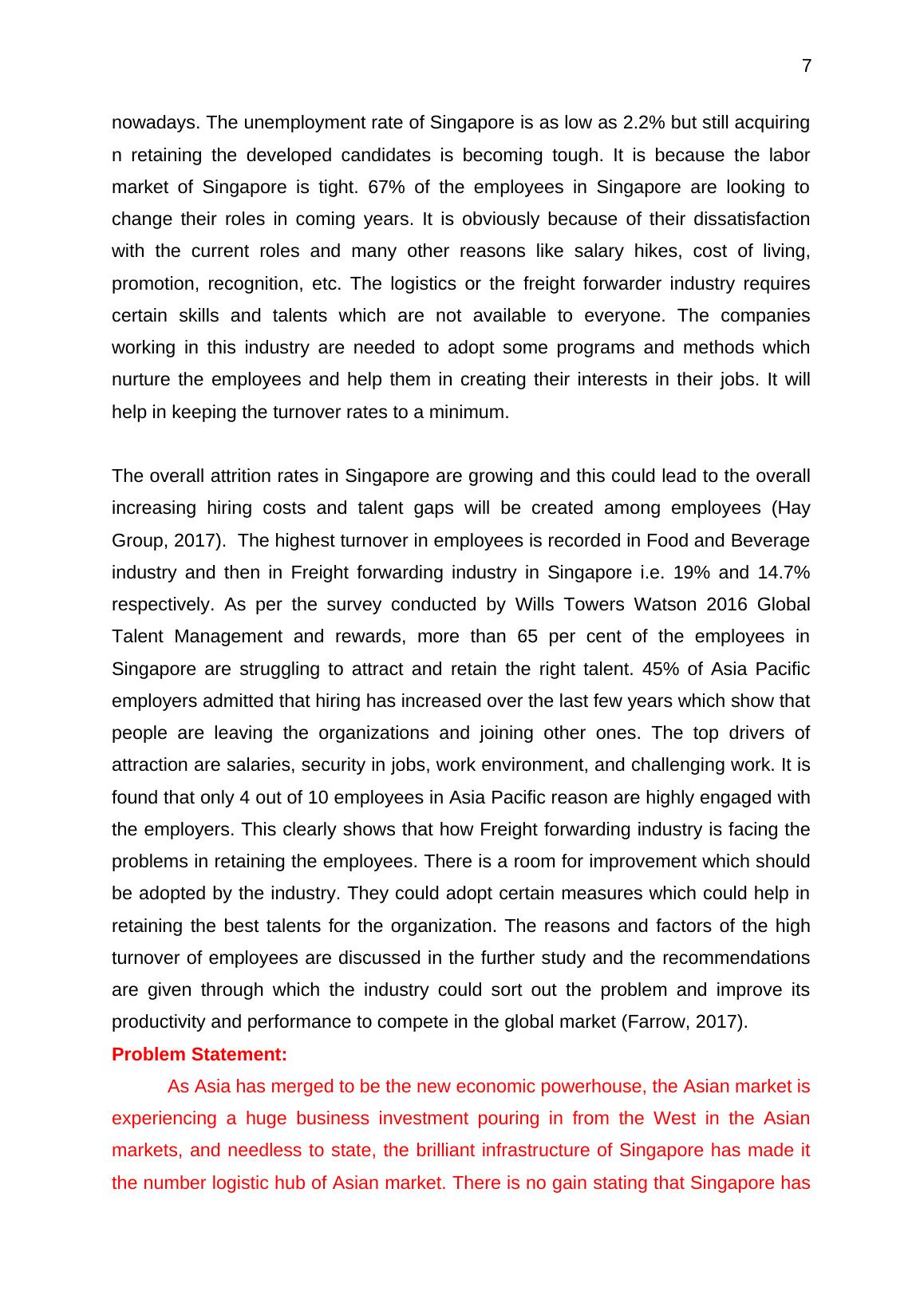
End of preview
Want to access all the pages? Upload your documents or become a member.
Related Documents
Dissertation - High Employee Turnover In Singaporelg...
|40
|11358
|347
Communication Gap within Abraj Energy Services: A Literature Reviewlg...
|99
|23019
|217
Impact of Work Life Balance on Staff Turnover in Marriott Hotelslg...
|49
|9909
|142
High Rate of Employee Turnover - PDFlg...
|2
|339
|44
Impact of COVID-19 on Operations and Strategies of UK Hospitality Sector: A Study on Nandoslg...
|49
|14048
|419
Research on Decline in Sales of Domino's Kingsland Storelg...
|57
|13382
|106
